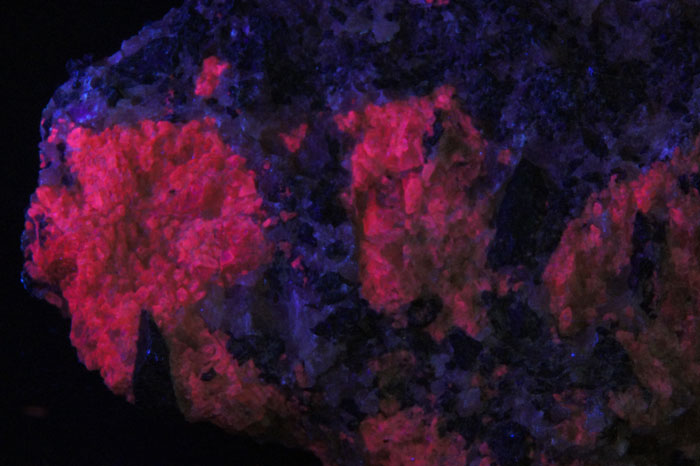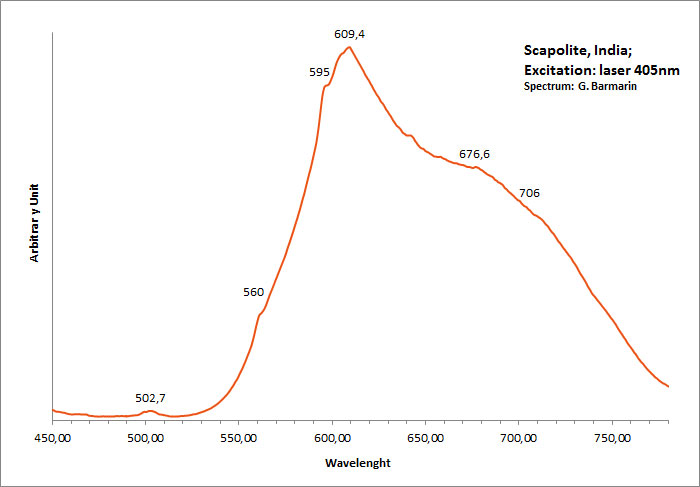Database of luminescent minerals
scapolite
Chemical formula: See MEIONITE / (Group: MEIONITE, MARIALITE )
Family: Silicates
Status:
Crystal system : Tetragonal
Display mineral: NON
Luminescence:
Longwave UV (365nm) colors: |
Violet red , Yellow , Orangy yellow , Orange , Dark Orange /Tawn , Orange Red , Red , Blue , Bluish , | ||
Midwave UV (320nm) colors: |
Orange Red , Yellowish White , Orangy yellow , Blue , Bluish , | ||
Shortwave UV (254nm) colors: |
Red , Bluish White , Yellowish White , Orangy yellow , Orange Red , Violet red , Blue , | ||
Daylight picture

scapolite, UV SW,
Photo & Col. © G. Barmarin
Shortwave (254nm) picture

Pictures Galery:



 ...
...  Go to the galery (17 pictures)
Go to the galery (17 pictures)
Do you have a photo of this mineral you would like to see in the gallery? Contact us!
Phosphorescence (in the common sense of the term) observable with the naked eye:
No data
Tenebrescence: OUI

Activator(s) and spectrum:
Activator(s): Fe3+, Pb2+, S2-, Eu2+, Mn2+ , O-2,
Peaks in the spectrum (nm):
Fe3+? : band at 710 - 720nm Mn2+ : broad band at 630 - 690nm

Comments on spectrum and activators:
Red fluorescence: Fe3+? (band at 710 - 720nm) Mn2+ (broad band at 630 - 690nm) Blue fluorescence: Pb2+ (Langban, Sweden) A recent find of colorless scapolite in Badakhshan ( Afghanistan) turns to a blue color when exposed to UVSW.
Best localities for fluorescence (*):
- Karur, Tamilnadu, India;
- Madagascar (dull red);
- Cannon Inlet, Baffin Island, Nunavut (bright peach under MW);
- Nobel Pit, Sterling Hill Mine, Ogdensburg, New Jersey, USA (gray scapolite fl. medium crimson red SW associated with calcite fl.bright red SW);
- Limecrest Quarry in NJ. The Scapolite ( yellow LW, yellowish-white MW & SW);
- Diamond Lade Roadcut, Hastings County, Ontario, Canada ((green scapolite fl. medium crimson red SW associated with calcite fl.bright red SW);
- Marble occurrence, Morogoro, Uluguru Mts, Morogoro Region, Tanzania (red SW, dull blue LW));
- Langban, Filipstad, Varmland, Sweden (SW blue-white, blue);
- Bancroft area, Hastings Co., Ontario, Canada (orange-pink fluo);
- Yates mine, Otter Lake, Pontiac RCM, Outaouais, Québec, Canada (red SW);
- Mountain Top Trucking quarry, Torrington, Litchfield Co., Connecticut, USA (red SW);
- Valyermo, Holcomb Ridge, Los Angeles Co., California, USA (yellow LW);
- Maple Leaf, Monteagle Township, Hastings Co., Ontario, Canada (dull orange);
- Yates mine, Otter Lake, Pontiac RCM, Outaouais, Québec, Canada (dull pink);
(*)The data are not exhaustive and are limited to a few remarkable localities for fluorescence
Bibliographic reference for luminescence:
- The Henkel Glossary of Fluorescent Minerals, Dr. Gerhard Henkel, Published by the FMS, 1989 ,
- Fluorescence: Gems and Minerals Under Ultraviolet Light, Manuel Robbins, 1994, Geoscience Press, ISBN 0-945005-13-X ,
- The World of Fluorescent Minerals, Stuart Schneider, Schiffer Publishing, 2006, ISBN 0-7643-2544-2 ,
- Luminescence Spectroscopy of Minerals and Materials, M. Gaft, R. Reisfeld, G. Panczer, Springer Editor, ISBN: 10 3-540-21918-8 ,
- Luminescent Spectra of Minerals, Boris S. Gorobets and Alexandre A. Rogojine, Moscow, 2002 ,
Reference for luminescence on the Internet:
- Marvelous Midwave, Jeffrey Shalli, UV-Waves, vol.39, November-December 2009
- MINERALOGICAL NOTES, THE X-RAY SPECTROGRAPHIC DETERMINATION OF SULPHUR COORDINATION IN SCAPOLITE, B. W. Chappell and J. R. White, The American Mineralogist, VOL . 53 , SEPTEMBER-OCTOBER, 1968
- Der Aufschluss, Vol.48, n°2 March/April 1997 Langban minerals by Fritz Blatter;
Image(s):
- Langban, Sweden: http://www.mindat.org/photo-208010.html
- Morogoro, Tanzania: http://www.mindat.org/photo-277961.html
- Morogoro, Tanzania: http://www.mindat.org/photo-280432.html
- Otter Lake, Québec, Canada : https://www.mindat.org/photo-803092.html
Mineralogical reference on the Internet:
 http://www.mindat.org/show.php?name=Scapolite
http://www.mindat.org/show.php?name=Scapolite
 http://webmineral.com/data/Scapolite.shtml
http://webmineral.com/data/Scapolite.shtml
Internet Search:
 Image search on 'Google Images'
Image search on 'Google Images'
 Search for documents in all languages on Google
Search for documents in all languages on Google
A request providing no result means only that no such reference exists in the database, but it does not mean that what you are looking for does not exist, just not to our knowledge. If you think you have found an error or omission, please let us know via the contact page being sure to cite the source of information.
